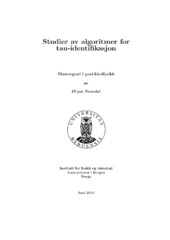Studier av algoritmer for tau-identifikasjon
Abstract
Mange signaturer for ny fysikk i ATLAS vil henfalle til eit eller fleire tau-lepton. Derfor har ATLAS utvikla verktøy for identifikasjon av tau-lepton som henfall eit eller fleire pion. Verktøya er kompliserte og inneheld stor grad av fleksibilitet. Bruken av desse verktøya må optimaliserast med hensyn på henfallskanal. Denne oppgaven går ut på å studera dei verktøya som er tilgjengelige, samt å optimalisere bruken av dei for å finne Z boson når dei henfell til to tau-partiklar. Det er nødvendig å forstå identifikasjonen av tau-leptona i denne kanalen før man kan gå vidare i søk etter nye partiklar. Skal ta utgangspunkt i dei variablane som er definert som trygge av ATLAS gruppa for å finna ein god måte å skilja dei tau leptona som kjem frå Z henfall frå alt som ikkje er tau-lepton frå Z henfall. Ein trygg variabel må vera godt forstått i dei tidlige stadiene når ATLAS byrjar datainnsamling. Det er 9 variablar som går under denne definisjonen, desse variablane er vist i tabell 3.1. Det er allerede utvikla trygge kutt for å seperera signal og bakgrunn i analyseverktøya, det er naturlig å samenlikna effektiviteten til dei trygge kutta mot effektiviten til kutt på likelihoodfunksjonen me har utvikla, noko som er gjort i tabell 4.2. The ATLAS working group has defined some safe variables that is well understood at the ATLAS early data taking. With these safe variables they have developed some safe cuts by using TMVA, that removes approximatly 70%(Loose), 50%(Medium), and 30%(Tight) of the signal. In this thesis I have made a likelihoodfunction based on the safe variables, figure 4.19, if we make cuts on this likelihood we manage to keep the same amount of signal while we reject more background than the safe cuts do. As shown in table 4.2 a cut on this likelihoodfunction will reject 5 times more background than the loose cut, and 2 times more background than the medium cut. This means that it can be a good idea to use those likelihoodcuts instead of using the safe cuts.
Publisher
The University of BergenCopyright
The authorCopyright the author. All rights reserved
